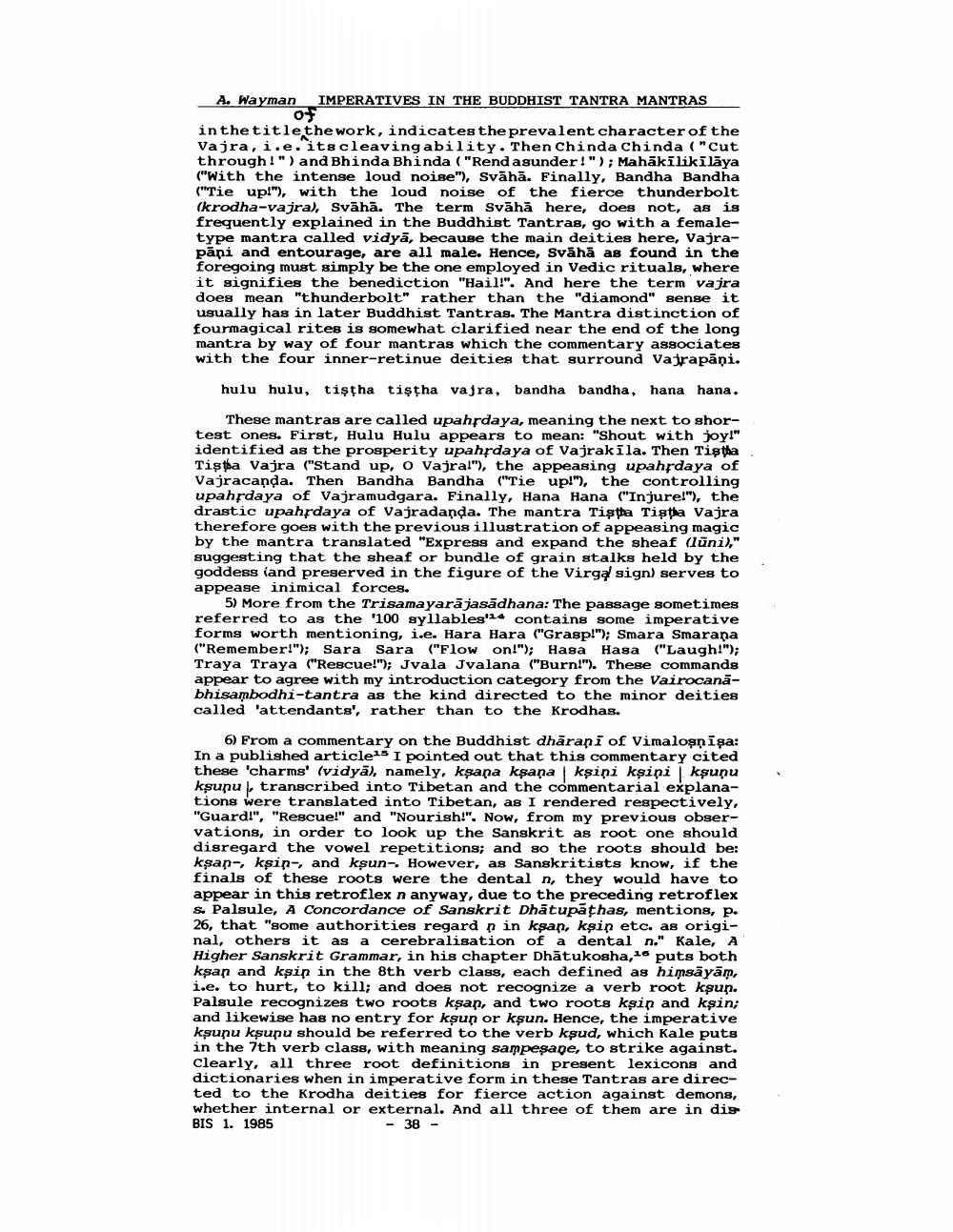Book Title: Imperatives In Buddhist Tantra Mantras Author(s): Alex Wayman Publisher: Alex Wayman View full book textPage 4
________________ A. Wayman IMPERATIVES IN THE BUDDHIST TANTRA MANTRAS of in the title the work, indicates the prevalent character of the Vajra, i.e. its cleaving ability. Then Chinda Chinda ("Cut through!") and Bhinda Bhinda ("Rend asunder!"); Mahākilikilāya ("With the intense loud noise"), Svāhā. Finally, Bandha Bandha ("Tie up!"), with the loud noise of the fierce thunderbolt (krodha-vajra), Svāhā. The term Svāhā here, does not, as is frequently explained in the Buddhist Tantras, go with a femaletype mantra called vidyā, because the main deities here, Vajrapāni and entourage, are all male. Hence, Sváha as found in the foregoing must simply be the one employed in Vedic rituals, where it signifies the benediction "Hail!". And here the term vajra does mean "thunderbolt" rather than the "diamond" sense it usually has in later Buddhist Tantras. The Mantra distinction of fourmagical rites is somewhat clarified near the end of the long mantra by way of four mantras which the commentary associates with the four inner-retinue deities that surround Vajrapāni. hulu hulu, tiştha tiştha vajra, bandha bandha, hana hana. These mantras are called upahrdaya, meaning the next to shortest ones. First, Hulu Hulu appears to mean: "Shout with joy!" identified as the prosperity upahrdaya of Vajrakila. Then Tistha Tistha Vajra ("Stand up, o Vajral"), the appeasing upahrdaya of Vajracanda. Then Bandha Bandha ("Tie up!"), the controlling upahrdaya of Vajramudgara. Finally, Hana Hana ("Injure!"), the drastic upahrdaya of Vajradanda. The mantra Tiştha Tiştha Vajra therefore goes with the previous illustration of appeasing magic by the mantra translated "Express and expand the sheaf (lūni)," suggesting that the sheaf or bundle of grain stalks held by the goddess land preserved in the figure of the Virga sign) serves to appease inimical forces. 5) More from the Trisama yarājasādhana: The passage sometimes referred to as the '100 syllables'2d contains some imperative forms worth mentioning, i.e. Hara Hara ("Grasp!"); Smara Smarana ("Remember!"); Sara Sara ("Flow on!"); Hasa Hasa ("Laugh!"); Traya Traya ("Rescue!"); Jvala Jvalana ("Burn!"). These commands appear to agree with my introduction category from the Vairocanabhisambodhi-tantra as the kind directed to the minor deities called 'attendants', rather than to the Krodhas. 6) From a commentary on the Buddhist dhārani of Vimaloşnişa: In a published article15 I pointed out that this commentary cited these 'charms' (vidyā), namely, kşana kşana kşini kşini kşunu kşunul, transcribed into Tibetan and the commentarial explanations were translated into Tibetan, as I rendered respectively, "Guardi", "Rescue!" and "Nourish!". Now, from my previous observations, in order to look up the Sanskrit as root one should disregard the vowel repetitions; and so the roots should be: kşap-, kşin-, and ksun-. However, as Sanskritists know, if the finals of these roots were the dental n, they would have to appear in this retroflex n anyway, due to the preceding retroflex S. Palsule, A Concordance of Sanskrit Dhātupāthas, mentions, p. 26, that "some authorities regard p in kşan, kşin etc. as original, others it as a cerebralisation of a dental n." Kale, A Higher Sanskrit Grammar, in his chapter kşan and kşin in the 8th verb class, each defined as himsāyām, i.e. to hurt, to kill; and does not recognize a verb root kşun. Palsule recognizes two roots kşap, and two roots kşin and kşin; and likewise has no entry for kşun or kşun. Hence, the imperative kşunu kşunu should be referred to the verb kşud, which Kale puts in the 7th verb class, with meaning sampeşape, to strike against. Clearly, all three root definitions in present lexicons and dictionaries when in imperative form in these Tantras are directed to the Krodha deities for fierce action against demons, whether internal or external. And all three of them are in dig BIS 1. 1985 - 38 -Page Navigation
1 2 3 4 5 6 7
